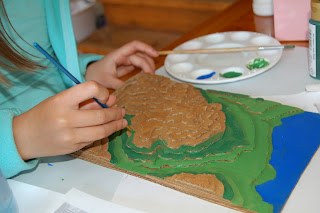 |
| Bokashi bin, and wheat-bran starter |
We've been outdoor composting for more than 20 years. We tried indoor vermicomposting for a while, but despite our best efforts couldn't entirely prevent fruit-fly outbreaks. We don't have a garage, so the worms were on their own outside, and eventually bears got the bin. And bears, really, are the problem. Yard waste won't attract them, but the food waste definitely does at certain times of year. Our solution has been to move the compost pile to the far corner of our property and let the bears snack as they like. But it's not ideal. Habituating the bears to human food waste is not such a great thing. Bears learn quickly and seem to share their knowledge through some sort of bear intranet. One compost bear tends to become several.
Winters present a different problem. Just getting to that faraway compost pile is a challenge when the snow is thigh-deep. No one likes doing it. Compost is the most dreaded chore on the kitchen chore rota. And of course, nothing actually rots during the winter, so in spring there's a gradual thawing of a mountain of food scraps. Just in time for the bears' arrival.
And now that most of us are eating meat a few times a week, we have the problem of bones and meat waste. We don't have garbage collection, so that stuff has to go into the freezer to be stored until we make our monthly trip to the dump.
So now we're trying something new. The chicken manure, leaves, garden waste, straw and grass clippings will keep going in the compost pile, but our food waste will go in our bokashi bin inside. Bokashi is Japanese for "fermented waste" and the bokashi approach to food waste processing was invented in Japan in 1980. It uses a combination of lactic acid bacteria, photosynthetic bacteria and yeast to ferment food and cellulose (i.e. wood/paper) anaerobically. Indoors, in a sealed container.
You put your food -- including citrus, meat, bones and dairy -- in a sealed drum or bucket with a wheat-bran "starter" which provides the micro-organisms necessary for fermentation. You sprinkle a little of the starter in every time you dump a day or two's worth of scraps into the drum, and re-seal it. Then, once it's completely full, you seal it fully for a minimum of 10-14 days. After that, it is fully fermented, won't attract animals, and is just waiting to fall apart into compost.
Last week we had a chance to intercept some bokashi bins at the post-fermentation stage. During the annual Garlic Festival in September, Fiona and I had worked a few hours on the waste management team. This meant directing visitors and food vendors to get all their recyclables in the appropriate bins, and to place any food or food/paper/wood waste in the buckets destined for the bokashi drums. The half-dozen 60-gallon drums underwent their fermentation, and were delivered to the school-and-community Harvest Festival last Friday by the bokashi guy. They were opened and dumped into trenches in the garden.
The stuff smelled pretty distinctive. Not horrid. Very cidery / vinegary. It was laced with the white mold that sometimes shows up in our compost pile and is a hallmark of a good bokashi process. Like the documentation suggested, it looked pretty much the same as it had when it went into the drums. It hadn't decomposed, but the bokashi guy assured me that much of the cell structure had been destroyed. It will apparently decompose in 10-30 days when mixed with soil or buried in a compost pile. The school bravely dumped a couple hundred gallons of the stuff into the garden beside the place where the little preschoolers play. And just as the bokashi buy promised, no bears have shown up.
I think it will take us 3 to 4 weeks to fill a 5-gallon drum. We have three drums. We'll fill two, wait the 14 days while working on the third one, and then take the fermented ones out to dump in the compost pile. That's one trip to the compost pile every 6-8 weeks. Two or three trips each winter. Sure, it'll require a sled. But that we can handle, given the infrequency of the requirement.
So far our bin smells cidery when opened, and harbours no flies. Thanksgiving turkey bits are in there, with dozens of plum pits, a few bamboo skewers, a lot of tea leaves, some paper and coffee grounds, a bunch of dried-out mozzarella cheese and the usual food scraps. Week one has gone as expected. We'll see how the winter goes.




